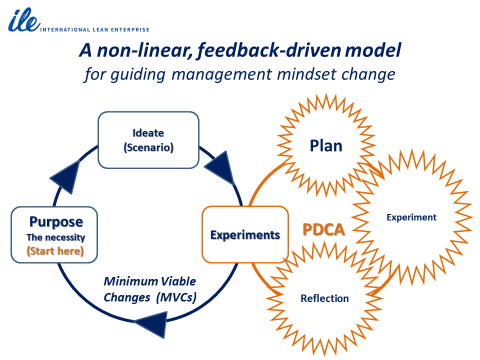Sustainable organizational change is created within an organization – not on its ruins. Therefore, the change must be accomplished in small steps, known as a Minimum Viable Change (MVC) but these incremental changes also require resources and conceptual flexibility.
“Change will come, whether you like it or not.”
— Greta Thunberg, climate change activists
An Unavoidable Crisis
Over the decades in which I have worked at leading or supporting organizational change, I have learned that as difficult as it is to make change happen – it is even more difficult to complete and maintain the change process. Like leadership, the phrase organizational change is commonly used in conversation, but is very rare in the field. Managers who have learned Lean principles (whether by participating in conferences or workshops or through reading books and summits) and want to bring what they have learned to their organization, usually find themselves in difficult, frustrating situations: implementing the Lean methodology did not change well-known work patterns and attitudes towards management fast enough, the members of the board are not willing to adopt and internalize the principles of change, and the workers are beginning to lose trust.
Flattening out a hierarchical organization creates a crisis of trust between management and the line workers. Essentially, this situation is inevitable in any change process. Up until now, a structured, hierarchical framework defined work relations, at the price of inflexibility and loss of organizational resilience. Now it must change, and change always involves a crisis.
Managers vs. the Teams in the Field
In the past, I used to think that, in order to change an organization, it was enough to provide the values and tools that form the basis of the Lean view of management, but time and time again I have come to face with the gap between learning values and acquiring tools and the ability to translate them into practical principles for day-to-day activities. Providing independence and autonomy to Agile work teams, and values such as the dignity of human beings and encouragement of critical thinking — which were readily accepted at the beginning of the journey towards change – become a source of frustration for the managers of the professional teams, who have provided the teams in the field with space for decision-making and received, they feel, the opposite of what they expected – peoples who drag their feet and try to avoid responsibility. This serves to reinforce the doubts that the managers had anyway held regarding the workers’ ability to function in an autonomous framework, without supervision and monitoring. The managers ask themselves, how can they trust the teams’ abilities to autonomously make decisions, when, in the final analysis, the managers are the ones who are ultimately responsible for the results.
From the individuals and teams’ point of view, at some point, the provision of autonomy feels like an abandonment – the senior managers are using the process as a cover for their avoidance of contact with the field. As the founder and CEO of a start-up, Be-Connected, I witnessed how the work teams in the field perceived the provision of autonomy in decision making as arrogance and distancing. The work teams are expected to make independent decisions, hold up to the stress of the tasks that do not allow for full investigative process (according to the A3 methodology) and, worst of all – they do not really see that the hierarchy is breaking down, since senior management can overrule their decisions. All of these work against the trustworthiness of the change leaders in the eyes of the workers and take the wind out of their sails.
The crisis can serve as a catalyst for changes in the roles of the managers and the teams, but how is it possible to advance change and limit the risk that the crisis entails? And no less important – how can trust be maintained among all of those involved in the process that disrupts the work environment with which they have been familiar?
Parallel Processes
The leader who leads the change is tasked with initiating several experimental processes that will simultaneously serve as a model for the outcome of the change, a product that is concrete in terms of the purpose of the change and is at the foundation of the in-depth process to reach long-term organizational resilience:
The first stage: Facilitating the use of Lean tools through experiential practice and coping with “urgent” fires that can provide immediate results.
The second stage: Changing the work environment and decision-making processes through small experiments according to the principles of LPPD, involving all stake-holders.
The third stage: Changing the view of management and redesigning the relationship between management and the workers, requiring all stakeholders to redefine the frameworks for decision-making, the procedures for dealing with problems, and their roles in the changing organization.

It is worth remembering that any process that seeks to create change throughout the depth and breadth of an organization must be suitable to the circumstances and must be conducted with respect for the existing organizational culture – sustainable change must be created within the organization, not on its ruins. Finally, the process must reflect systemic understanding of the interactive relations, mutual influences, and side effects that result from each and every decision and action. This demands a great deal of empathy, curiosity, and patience.
And experience has taught me one more thing: sustainable change is not the result of decisions handed down from above, preaching, or directing; rather, it is created as part of an ongoing dialogue that crosses borders, units and hierarchies and is based on learning through experimentation. The members of the organization may discover that they are not yet ready to change and be changed, yet change will come – and it is better to initiate that change than to be dragged into it out of a lack of choice.
Boaz Tamir, ILE.
Leave a Reply